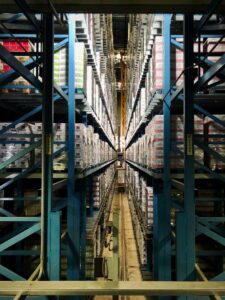The enduring effects of the pandemic have been “challenging”, to say the least.
Shipping container rates have jumped nearly tenfold.
Labor shortages continue, with 49% of U.S. small business owners stating they have job openings they can’t fill
Domestic shipping costs, via road and rail in North America, increased 43% from July 2020 to July 2021.
Delivery delays. Skyrocketing costs. Inflation.
Few industries have been left unscathed by the global supply chain chaos.
But…
If you look hard enough, there are some gems hiding in plain sight.
Here are three key industry segments you should pay attention to if you sell material handling equipment for a living:
Food Processing & Cold Storage
 U.S. retail food sales exceeded $876 billion dollars in 2020.
U.S. retail food sales exceeded $876 billion dollars in 2020.
It’s an industry segment that has been growing EVERY single year since 2009.
(And many claim the 2009 anomaly was just a result of the Great Recession. There were also 11 years of consistent growth from 1997 to 2008).
What makes this growth path so reliable?
The U.S. population is growing by 1.6 million people per year.
Human beings need to eat.
Large volumes of food get produced and packed onto pallets for road and rail transport across North America every single day.
And these same skids then require handling to move through the supply chain, making their way from food manufacturers to a retail outlet like your local grocery store.
In fact, many people don’t know that 70% of the food we consume passes through the ‘cold chain’.
These are additional temperature-controlled warehouses, containers, and trucks that can require special material handling equipment to accommodate cold temperatures in order to prevent food spoilage.
Until people stop eating, this industry segment shows no signs of slowing down.
Lumber & Building Materials
 According to the U.S. Census Bureau, an estimated 811,000 new homes were sold in 2020.
According to the U.S. Census Bureau, an estimated 811,000 new homes were sold in 2020.
19% more than 2019’s 683,000 new homes.
When you consider Maslow’s hierarchy of needs, it’s simple really. Food and Shelter are two of our most basic needs.
There’s still incredible demand for housing in many North American markets right now.
Lumber mills, retail lumber yards, and landscape wholesale distributors all require handling equipment to move material in and around their facilities.
“Are you kidding? Real estate is ridiculously overpriced right now, I’m staying put in my current residence,” you exclaim.
Good catch. You’re not the only one.
Home improvement spending also reached record levels due in large part to COVID and continuing social distancing measures.
For some, that might mean a new deck in the backyard. A kitchen reno. Or maybe finishing the basement.
All told, the Home Improvement Research Institute believes the best is yet to come for this $440 billion industry.
Pulp & Paper Manufacturing
 According to Digital Commerce 360, it’s estimated that overall U.S. eCommerce sales grew to $839 billion in 2020.
According to Digital Commerce 360, it’s estimated that overall U.S. eCommerce sales grew to $839 billion in 2020.
That’s 40% higher than 2019’s figure of $598 billion and a LOT of corresponding cardboard boxes.
When the pandemic hit and people shifted their buying habits online, it required more packaging to safely deliver products to homes across North America.
Yes, those numbers dipped in 2021 as people resumed shopping in-person in some areas. But the web’s share of spending is still higher than it was pre-pandemic (and continues to grow).
And who can forget the Great Toilet Paper Drought? Consumer demand for toilet paper spiked 845% when COVID first hit back in 2020.
It has since stabilized, but the U.S. still produces 7 billion pounds of toilet paper per year.
Facilities like paper mills and the various warehouses these products move through require material handling attachments, and an assortment of material handling equipment in order to optimize workflows.
Conclusion
In the end, it doesn’t take much for working conditions in certain environments to get uncomfortable.
Below-zero temperatures. Extreme heat. Or just plain dirty working conditions can impede operator safety.
An enclosed operator cab minimizes these distractions, keeping operators comfortable and productive while doing this sort of work. If you need help navigating options, or with a particular application, we would love to assist you.

